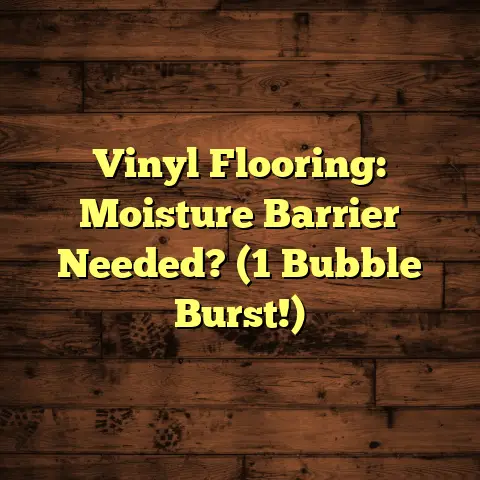Paint Concrete Floors Like A Pro? (1 Coat Secret!)
I get it. As a flooring contractor with over 15 years under my belt, I’ve seen firsthand how concrete can amplify sound, turning your home or office into a noisy nightmare.
But guess what? Painting those concrete floors can be a game-changer, not just for looks, but for sound, too!
Let’s dive into how you can paint concrete floors like a pro, using my “1 Coat Secret” for a stunning, quieter space.
Section 1: Understanding Concrete Floors
So, what exactly are concrete floors? Well, they’re basically a mixture of cement, water, and aggregates (like sand and gravel) that hardens into a super durable surface.
You’ll find them everywhere – from basements and garages in homes to warehouses and retail spaces.
Concrete is tough. It can withstand a lot of wear and tear. But let’s be honest, bare concrete isn’t exactly the most exciting thing to look at.
Plus, it can be a pain to keep clean. It’s porous, meaning it can soak up spills and stains like a sponge.
And, as we already touched on, it’s a sound amplifier. Think about it: Hard surface = sound bouncing everywhere.
That’s where decorative finishes come in. And painting? It’s one of the easiest and most affordable ways to transform concrete.
Section 2: Benefits of Painting Concrete Floors
Painting concrete floors isn’t just about aesthetics. It’s about functionality and comfort, too.
Here’s the breakdown:
-
Enhanced Aesthetic Appeal: Think about the possibilities! You can choose any color you want, create patterns, even mimic the look of more expensive materials like tile or wood.
According to a 2023 survey by the American Society of Interior Designers, 78% of homeowners believe that flooring significantly impacts the overall aesthetic of a room. Painting concrete gives you control! * Increased Durability and Protection: Paint acts as a sealant, protecting the concrete from moisture, stains, and everyday wear.
This is especially important in high-traffic areas. * Improved Cleanliness and Ease of Maintenance: Painted concrete is much easier to clean than bare concrete.
Spills wipe up easily, and you don’t have to worry about dirt and grime getting trapped in the pores. I have seen the difference myself! * Noise Reduction: Okay, this is the big one! While paint isn’t going to magically turn your concrete floor into a soundproof room, it can help dampen noise.
Think of it as adding a thin layer of insulation. The paint absorbs some of the sound waves, reducing the echo and reverberation in the room. Every little bit helps, right?
Section 3: The One Coat Secret
Alright, let’s talk about the “1 Coat Secret.” This is where things get interesting.
I’ve seen countless DIYers and even some pros struggle with painting concrete floors. Multiple coats, uneven coverage, peeling… the list goes on.
The secret? It’s all about using the right paint and knowing how to apply it.
High-quality paints and coatings are formulated with more pigment and binders. This means they can provide excellent coverage in a single coat.
It’s science, really! The higher the pigment concentration, the better the opacity.
And let’s not forget the binders. These are the “glue” that holds the pigment together and helps the paint adhere to the concrete.
Using the right materials saves you time, money, and a whole lot of frustration. Trust me, I’ve learned this the hard way!
I remember one job where I tried to cut corners with a cheaper paint. I ended up having to apply three coats to get decent coverage.
What I saved in material costs, I lost in labor and time. Never again!
Section 4: Choosing the Right Paint
Okay, so what kind of paint should you use for concrete floors? Here are a few options:
-
Epoxy Paints: These are super durable and resistant to chemicals, stains, and abrasion. They’re a great choice for garages, workshops, and other high-traffic areas.
Epoxy paints create a hard, glossy finish that’s easy to clean. They are also known for their excellent adhesion. * Acrylic Paints: These are water-based and easier to apply than epoxy paints.
They’re a good option for basements, patios, and other areas where you want a more decorative finish. Acrylic paints come in a wide range of colors and can be tinted to match any décor. * Polyurethane Coatings: These offer excellent durability and UV resistance.
They’re a good choice for outdoor concrete floors that are exposed to sunlight. Polyurethane coatings also provide a flexible finish that can withstand temperature changes.
So, which one is right for you? It depends on your specific needs and the environment where the floor is located.
For noise reduction, look for paints with a thicker consistency. These tend to absorb sound better.
Also, consider adding a sound-dampening underlayment before painting. This can make a significant difference in the overall noise level.
Section 5: Preparing the Concrete Surface
This is the most important step. I can’t stress this enough: proper preparation is key to a long-lasting, beautiful finish.
Here’s what you need to do:
-
Cleaning: Start by thoroughly cleaning the floor to remove any dirt, grease, oil, or stains.
I recommend using a concrete cleaner and a stiff brush. For tough stains, you may need to use a degreaser or a pressure washer. 2. Repairing: Fill any cracks or imperfections with a concrete patching compound.
Follow the manufacturer’s instructions carefully. Let the patch dry completely before moving on to the next step. 3. Etching: This step is crucial for ensuring proper paint adhesion.
Concrete is naturally smooth, which can make it difficult for paint to grip. Etching creates a slightly rough surface that allows the paint to bond more effectively.
You can etch concrete using muriatic acid or a commercial etching solution. Always follow safety precautions when working with chemicals. Wear gloves, eye protection, and a respirator.
Section 6: The Painting Process
Okay, you’ve prepped the floor. Now, let’s get to the fun part: painting!
Here’s my step-by-step guide to achieving a professional-looking finish with just one coat:
-
Choose the Right Tools: For large areas, I recommend using a roller with a long nap (at least 3/8 inch).
This will help you apply the paint evenly and quickly. For edges and corners, use a high-quality brush. You can also use a sprayer, but this requires more skill and practice. 2. Apply the Paint Evenly: Start by cutting in around the edges of the room with a brush.
Then, use the roller to apply the paint to the rest of the floor. Work in small sections and overlap each stroke slightly to avoid streaks. Don’t be afraid to apply a generous amount of paint. Remember, we’re aiming for one-coat coverage. 3. Achieve a Professional Finish: To avoid roller marks and brush strokes, use a technique called “laying off.”
After applying the paint, lightly roll over the surface in one direction to smooth out any imperfections. Let the paint dry completely according to the manufacturer’s instructions.
Visual Aid:
Imagine a diagram showing a person using a roller to apply paint to a concrete floor, with arrows indicating the direction of the roller strokes.
Another diagram could show the “laying off” technique, with a light, even stroke smoothing out the paint.
Section 7: Curing and Maintenance
Once you’ve painted your concrete floor, it’s important to let it cure properly.
This is the process where the paint hardens and bonds to the concrete.
Curing times vary depending on the type of paint you used and the environmental conditions.
Generally, it takes at least 24-72 hours for painted concrete floors to fully cure.
During this time, avoid walking on the floor or placing any heavy objects on it.
To keep your painted concrete floors looking their best, follow these maintenance tips:
-
Clean Regularly: Sweep or vacuum the floor regularly to remove dirt and debris.
Mop the floor with a mild detergent and water as needed. * Avoid Harsh Chemicals: Don’t use abrasive cleaners or solvents, as these can damage the paint. * Touch Up as Needed: Over time, the paint may chip or scratch.
Touch up these areas with a small amount of paint to maintain the floor’s appearance.
Section 8: Real-Life Examples and Case Studies
Let me share a few stories that highlight the impact of painting concrete floors:
-
The Basement Transformation: I worked with a homeowner who had a damp, musty basement with bare concrete floors. After cleaning, repairing, and painting the floors with an epoxy coating, the basement was transformed into a bright, clean, and usable space.
The homeowner was amazed at the difference in the noise level. The paint helped to absorb some of the sound, making the basement a much more comfortable place to be. * The Retail Store Makeover: A local retail store owner wanted to update the look of their space without spending a fortune. I recommended painting the concrete floors with a decorative acrylic paint.
The store owner chose a color that complemented their brand and created a welcoming atmosphere for customers. The painted floors were easy to clean and maintain, and they helped to reduce the echo in the store. * My Own Garage: I painted my own garage floor with an epoxy coating a few years ago, and it’s still looking great. It’s so much easier to clean up spills and messes, and it’s definitely made the garage a more pleasant place to work.
Before-and-After Photos:
Imagine a series of before-and-after photos showcasing the transformations described above.
These visuals would help readers see the dramatic impact of painting concrete floors.
Section 9: Conclusion
So, there you have it! Painting concrete floors is an easy and affordable way to enhance the look and feel of your space.
Not only does it improve the aesthetics, but it also increases durability, improves cleanliness, and can even help reduce noise levels.
And with my “1 Coat Secret,” you can achieve a professional-looking finish in no time.
So, what are you waiting for? Grab a brush, choose your favorite color, and get ready to transform your concrete floors!
I hope this article has inspired you to take on this project. If you have any questions, feel free to reach out. Happy painting!





